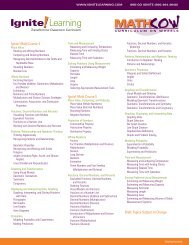The Silent Epidemic: Perspectives of High School ... - Ignite! Learning
The Silent Epidemic: Perspectives of High School ... - Ignite! Learning
The Silent Epidemic: Perspectives of High School ... - Ignite! Learning
You also want an ePaper? Increase the reach of your titles
YUMPU automatically turns print PDFs into web optimized ePapers that Google loves.
Bibliography<br />
in America. Edited by Gary Orfield. Cambridge, MA:<br />
Harvard Education Press.<br />
Eagle, E. (1994). Socioeconomic Status, Family<br />
Structure, and Parental Involvement: <strong>The</strong> Correlates <strong>of</strong><br />
Achievement. Presented in “A New Generation <strong>of</strong><br />
Evidence: <strong>The</strong> Family is Critical to Student<br />
Achievement.” Edited by A.T. Henderson & N. Berla.<br />
Washington, DC: Center for Law and Education: 59-60.<br />
Ensminger, M.E. & A.L. Slusacick (1992). Paths to <strong>High</strong><br />
<strong>School</strong> Graduation or Dropout: A Longitudinal Study <strong>of</strong> a<br />
First Grade Cohort. Sociology <strong>of</strong> Education 65: 95-113.<br />
Feller, Ben (June 23, 2005). States Reporting Inflated<br />
Graduation Rates. Washington Post.<br />
Fitsimmons, S.J.; Cheever; Leonard and Macunovich<br />
(1969). <strong>School</strong> Failure Now and Tomorrow.<br />
Developmental Psychology I, 134-146.<br />
Fry, Richard (2003). <strong>High</strong> <strong>School</strong> Dropout Rates for<br />
Latino Youth. ERIC Clearinghouse on Urban Education.<br />
Accessed at: www.ericdigests.org/2004-3/latino.html.<br />
Fry, Richard (2003). Hispanic Youth Dropping Out <strong>of</strong><br />
U.S. <strong>School</strong>s: Measuring the Challenge. Washington, DC:<br />
Pew Hispanic Center.<br />
Gardener, Rebecca (2002). Destination: Graduation.<br />
Dropout Prevention New York State Style. Paper presented<br />
at the “Adolescent and <strong>School</strong> Health Annual<br />
Conference”. Washington, DC: Center for Disease<br />
Control and Prevention.<br />
Garnier, H.E.; J.A. Stein & J.K. Jacobs (1997). <strong>The</strong><br />
Process <strong>of</strong> Dropping Out <strong>of</strong> <strong>High</strong> <strong>School</strong>. American<br />
Educational Research Journal Volume 34, Issue 2:<br />
395-419.<br />
Goodland, John (1984). A Place Called <strong>School</strong>. New<br />
York: McGraw-Hill.<br />
Green, Leonard; Astrid F. Fry & Joel Myerson (1994).<br />
Discounting <strong>of</strong> Delayed Rewards: A Life-span<br />
Comparison. Psychological Science, v5 n1: 33.<br />
Greene, Jay P. (revised 2002). <strong>High</strong> <strong>School</strong> Graduation<br />
Rates in the United States. New York: <strong>The</strong> Manhattan<br />
Institute for Policy Research.<br />
32<br />
Greene Jay P. & Marcus Winters (2002). Public <strong>School</strong><br />
Graduation Rates in the United States. New York: <strong>The</strong><br />
Manhattan Institute for Policy Research.<br />
Greene, Jay P. & Marcus Winters (2005). Public <strong>High</strong><br />
<strong>School</strong> Graduation and College Readiness Rates:<br />
1991 – 2002. New York: Manhattan Institute for<br />
Policy Research.<br />
Greene, Jay & Greg Forster (2003). Public <strong>High</strong> <strong>School</strong><br />
Graduation and College Readiness Rates in the United<br />
States. New York: Manhattan Institute for Policy<br />
Research, No. 3.<br />
Hall, Daria (2005). Getting Honest About Grad Rates:<br />
How States Play the Numbers and Students Lose.<br />
Washington, DC: Education Trust.<br />
Harlow, C. W. (2003, January. Revised April 15, 2003).<br />
Education and Correctional Populations. Bureau <strong>of</strong><br />
Justice Statistics Special Report. Washington, DC: U.S.<br />
Department <strong>of</strong> Justice. Accessed at:<br />
www.ojp.usdoj.gov/bjs/pub/pdf/ecp.pdf.<br />
Harmacek, Marilyn, ed. (2002). Youth Out Of <strong>School</strong>:<br />
Linking Absences to Delinquency. 2nd edition. Colorado:<br />
<strong>The</strong> Colorado Foundation for Families and Children.<br />
Harvey, James & Naomi Housman (2005). Crisis or<br />
Possibility: Conversations about the American <strong>High</strong><br />
<strong>School</strong>. Washington, DC: National <strong>High</strong> <strong>School</strong> Alliance.<br />
Hauser, R.M. (1999). Should We End Social Promotion?<br />
Truth and Consequences. Center for Demography<br />
and Ecology.<br />
Helfand, Duke (March 24, 2005). Nearly Half <strong>of</strong><br />
Blacks, Latinos Drop Out, <strong>School</strong> Study Shows.<br />
Los Angeles Times.<br />
Henderson, A. T. & N. Berla, eds. (1994). A New<br />
Generation <strong>of</strong> Evidence: <strong>The</strong> Family is Critical to<br />
Student Achievement. Washington, DC: Center for<br />
Law and Education.<br />
Houtenville, Andrew J. & Karen Smith Conway<br />
(2005). Parental Effort, <strong>School</strong> Resources and<br />
Student Achievement: Why Money May Not ‘Matter’.<br />
New Hampshire: University <strong>of</strong> New Hampshire.








